 Here is a new custom autoharp commissioned by a musician and performer from Ontario. He desired a bright white “dove of peace” shaped sound hole on an all black body. The dove shape that he chose was too delicate to cut into the soundboard so I inlayed it in a walnut veneer ring with a bright white plastic material.
Here is a new custom autoharp commissioned by a musician and performer from Ontario. He desired a bright white “dove of peace” shaped sound hole on an all black body. The dove shape that he chose was too delicate to cut into the soundboard so I inlayed it in a walnut veneer ring with a bright white plastic material.
The opaque black body finish was a learning experience for me as I have always finished my instruments to show the natural woodgrain. Wood finishing requires a lot of between-the-coats sanding and with an opaque finish it’s possible to sand right through to the bare wood. To avoid this potential problem I dyed the wood black, applied multiple coats of black grain filler and lacquer, and followed with several coats of satin lacquer. A satin finish was preferred over a gloss finish in the hope that the unavoidable fingerprints and chord felt dust would not be as visible.
 Walnut was the choice for the bridges, chord bars, chord bar buttons, bar comb covers, and tailpiece. Along with the brass hardware it makes for a subtle contrast to the solid black body.
Walnut was the choice for the bridges, chord bars, chord bar buttons, bar comb covers, and tailpiece. Along with the brass hardware it makes for a subtle contrast to the solid black body.

Black delrin locks on the ends of the lockbars. The bar is pressed and the locks slide to wedge under the covers.
The instrument is set up as a thirty-seven string diatonic in the keys of G and D. The fifteen chord bars are arranged in three rows with the major chords in the middle, the sevenths on the top, and the minors in the bottom row. The two chord bars nearest the tail end are lock bars. One is a D lockbar that mutes the strings in the array that aren’t in the key of D (four C strings and one F). The G lockbar mutes the strings in the array not in the key of G ( two C# strings and one F). By muting the unnecessary notes the player is less likely to play them by mistake.

Chord array before cutting the felt and installing the locks.
One might wonder why there is an F note on a G/D autoharp. By changing one string in an F# pair to F and cutting an F chord bar, this autoharp can also play the IV chord needed in the key of C.
 The thirty-seven strings are anchored at the tail end with a set of Daigle Flatline fine tuners. Each string can be fine tuned by turning its allen screw with a small wrench. This is especially useful with a diatonic autoharp that has several string pairs that need to be tuned in unison and beatless. Fine tuners are also helpful for tweaking the strings that go a little sharp or flat from day to day environmental changes in temperature and humidity.
The thirty-seven strings are anchored at the tail end with a set of Daigle Flatline fine tuners. Each string can be fine tuned by turning its allen screw with a small wrench. This is especially useful with a diatonic autoharp that has several string pairs that need to be tuned in unison and beatless. Fine tuners are also helpful for tweaking the strings that go a little sharp or flat from day to day environmental changes in temperature and humidity.
A wood handled allen wrench was supplied with the tuning assembly but I made an additional, smaller one that seats magnetically in a hole at the end of the tailpiece. It’s handy, right there near the tuners and not lost amid all of the other paraphernalia that travels with the instrument.
The new owner performs at a variety of venues, open mics, and with a regular bluegrass jam. He uses a sound system when he performs and plays his instruments unamplified with the bluegrass. The Dove can be amplified via a Schreiber electromagnetic pickup that is invisibly installed on the soundboard underneath the chord bars. It is wired to a 1/4″ jack that is imbedded flush on curved treble bout. 
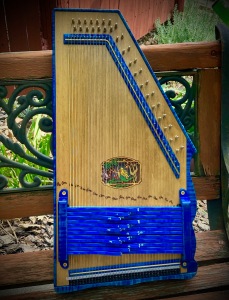 As a landlocked luthier here in Ohio, I truly miss the ocean. Marsha and I have lived in a coastal town on the Great Barrier Reef. We have wandered beaches in Florida, Cape Cod, Oregon, Nova Scotia, Iceland, and Ireland. We even spent two months at sea working on a container ship that crossed both Tropics and the Equator. With only some photos and a smattering of shells to sustain our fading memories, I sometimes regret leaving those experiences behind for life in the flatlands.
As a landlocked luthier here in Ohio, I truly miss the ocean. Marsha and I have lived in a coastal town on the Great Barrier Reef. We have wandered beaches in Florida, Cape Cod, Oregon, Nova Scotia, Iceland, and Ireland. We even spent two months at sea working on a container ship that crossed both Tropics and the Equator. With only some photos and a smattering of shells to sustain our fading memories, I sometimes regret leaving those experiences behind for life in the flatlands. This thirty-seven string instrument has twelve chord bars shaped like waves. The three rows of buttons resemble white caps. Bridges, chord bar holders, tail cover, and side trim are made of curly maple dyed bright blue to show an iridescent, wave like grain.
This thirty-seven string instrument has twelve chord bars shaped like waves. The three rows of buttons resemble white caps. Bridges, chord bar holders, tail cover, and side trim are made of curly maple dyed bright blue to show an iridescent, wave like grain.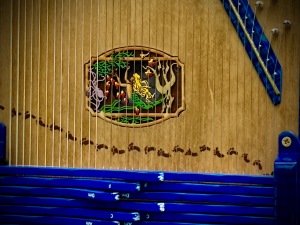 A laser cut rosette adorns the sound hole and bare footprints cross the sandy colored solid spruce soundboard.
A laser cut rosette adorns the sound hole and bare footprints cross the sandy colored solid spruce soundboard.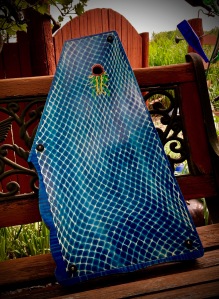 The laminated back has been painted bright blue using netting as a stencil. Captured in this fish net is a colorful jellyfish soundhole.
The laminated back has been painted bright blue using netting as a stencil. Captured in this fish net is a colorful jellyfish soundhole.
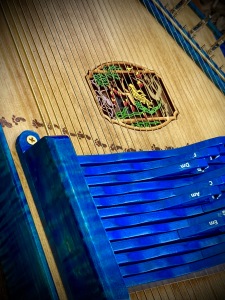
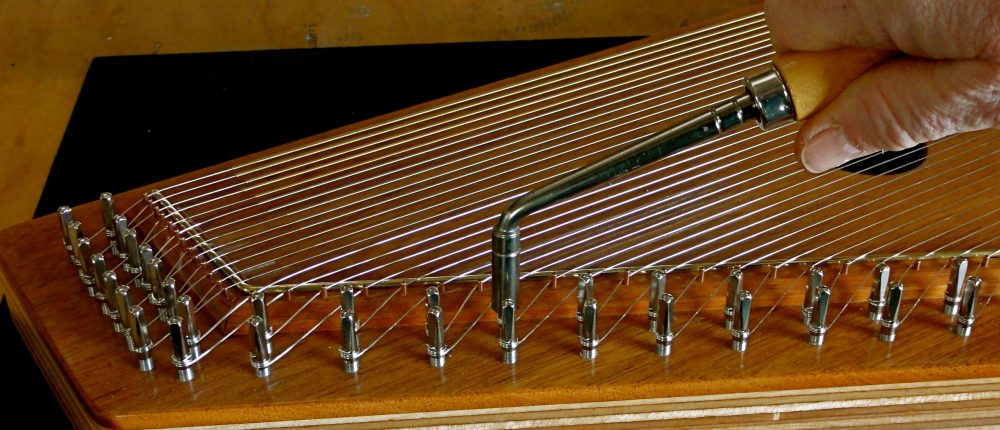
 I recently completed is this thirty-seven string diatonic autoharp in the single key of A. I built it for ourselves because Marsha and I are trying to sing along with our instruments more and find that the key of A is a comfortable range for our voices. Being a single key diatonic, it has paired string courses in the middle octave and only the notes needed for chords in the key of A. This produces a very rich and full tone that works nicely for strumming accompaniment and playing melody.
I recently completed is this thirty-seven string diatonic autoharp in the single key of A. I built it for ourselves because Marsha and I are trying to sing along with our instruments more and find that the key of A is a comfortable range for our voices. Being a single key diatonic, it has paired string courses in the middle octave and only the notes needed for chords in the key of A. This produces a very rich and full tone that works nicely for strumming accompaniment and playing melody.
 Fifteen chords are arranged in a “Bowers” type setup with major chords in the center row, sevenths in the top row, and minors in the bottom row. This familiar arrangement is in place on all of Marsha’s instruments and permits a sort of “motor memory” to kick in when she changes from one autoharp to another, even if in different keys. Seven of the chords are “color chords” for enhanced arrangements.
Fifteen chords are arranged in a “Bowers” type setup with major chords in the center row, sevenths in the top row, and minors in the bottom row. This familiar arrangement is in place on all of Marsha’s instruments and permits a sort of “motor memory” to kick in when she changes from one autoharp to another, even if in different keys. Seven of the chords are “color chords” for enhanced arrangements. The instrument has a 1/4 inch thick solid spruce soundboard. The one piece frame is laminated maple pinblock with a laminated maple back. The side veneer, end cover, and chord bar covers are made of curly maple. Chord bars are maple with alternate bars painted black. Black tuning pins, bridges, Schreiber fine tuners, and purfling complete the black/white motif.
The instrument has a 1/4 inch thick solid spruce soundboard. The one piece frame is laminated maple pinblock with a laminated maple back. The side veneer, end cover, and chord bar covers are made of curly maple. Chord bars are maple with alternate bars painted black. Black tuning pins, bridges, Schreiber fine tuners, and purfling complete the black/white motif.
 I recently completed and delivered this commissioned instrument to a musician in New York state. After the initial contact and much discussion by e-mail, the entire process required only three months. The wait probably seemed longer to the musician anxious to receive his first luthier built autoharp but its completion was well within my usual two to five month time estimate.
I recently completed and delivered this commissioned instrument to a musician in New York state. After the initial contact and much discussion by e-mail, the entire process required only three months. The wait probably seemed longer to the musician anxious to receive his first luthier built autoharp but its completion was well within my usual two to five month time estimate.

 The chord bars, bridges, side veneer, chord bar covers, and tail cover are made of African mahogany stained with Minwax red mahogany oil stain. The chord bar covers, chord buttons, and tail cover are capped with curly maple finished natural. The soundboard is spruce, the back is maple veneer, and everything is finished with up to six coats of semi-gloss Deft lacquer.
The chord bars, bridges, side veneer, chord bar covers, and tail cover are made of African mahogany stained with Minwax red mahogany oil stain. The chord bar covers, chord buttons, and tail cover are capped with curly maple finished natural. The soundboard is spruce, the back is maple veneer, and everything is finished with up to six coats of semi-gloss Deft lacquer. The Schreiber electromagnetic pickup is specially wound for this thirty-seven string array and is fastened underneath the chord bars by metal tabs that fit in slots on the underside of the Delrin chord bar combs. A small length of coax is routed through the inside of the instrument to a 1/4″ jack.
The Schreiber electromagnetic pickup is specially wound for this thirty-seven string array and is fastened underneath the chord bars by metal tabs that fit in slots on the underside of the Delrin chord bar combs. A small length of coax is routed through the inside of the instrument to a 1/4″ jack. Many of my autoharps are shipped out of state and abroad to musicians who will likely want to experiment with alternative chords or attend to future DIY adjustments and repairs. For this I include some extra blank felted chord bars, extra chord felt, self adhesive under cover felt, and extra springs. The wrapper from the custom string set will help them order the proper strings when it becomes necessary and a laminated strip indicates the tuning of each string. Also included is the allen wrench that comes with the fine tuners and a new star tipped T-wrench.
Many of my autoharps are shipped out of state and abroad to musicians who will likely want to experiment with alternative chords or attend to future DIY adjustments and repairs. For this I include some extra blank felted chord bars, extra chord felt, self adhesive under cover felt, and extra springs. The wrapper from the custom string set will help them order the proper strings when it becomes necessary and a laminated strip indicates the tuning of each string. Also included is the allen wrench that comes with the fine tuners and a new star tipped T-wrench. The latest from here at Fretnot Laboratories is this custom thirty-seven string, fifteen bar diatonic in the keys of G and D. It features Daigle fine tuners, two lock bars, flat chord bar buttons, and five extra blank chord bars for future substitutions. A custom oval rosette was fashioned using walnut burl and plastic white-black-white purfling. Walnut burl also trims the tops of the chord bar covers and the tail end cover.
The latest from here at Fretnot Laboratories is this custom thirty-seven string, fifteen bar diatonic in the keys of G and D. It features Daigle fine tuners, two lock bars, flat chord bar buttons, and five extra blank chord bars for future substitutions. A custom oval rosette was fashioned using walnut burl and plastic white-black-white purfling. Walnut burl also trims the tops of the chord bar covers and the tail end cover.

 Since introducing my new twenty-three string, seven chord child size autoharps two months ago, I received a lot of interest and positive comments. My goal was to produce a serious instrument for the young learner to play while growing into a standard, full size autoharp. I guess I wasn’t too surprised when several adults found them to be a good size as a travel instrument or for someone challenged by the size and weight of a more standard autoharp. At only eighteen inches long and weighing only four and one-half pounds, they are easy to hold and carry.
Since introducing my new twenty-three string, seven chord child size autoharps two months ago, I received a lot of interest and positive comments. My goal was to produce a serious instrument for the young learner to play while growing into a standard, full size autoharp. I guess I wasn’t too surprised when several adults found them to be a good size as a travel instrument or for someone challenged by the size and weight of a more standard autoharp. At only eighteen inches long and weighing only four and one-half pounds, they are easy to hold and carry.


 The latest autoharp to emerge from my workshop is this thirty-seven string diatonic beauty ordered only two months ago by an autoharp friend named Lori. She currently plays chromatic autoharps and was amazed at the richer tone and greater volume of a two key diatonic. She often plays in the key of D with a dulcimer group but also finds the keys of G, C, and A useful. This diatonic is primarily set up for the keys of D and G but with the addition of a single F string can play the F chord needed for the key of C. The key of A is also present with the chords A, D, and a partial E7.
The latest autoharp to emerge from my workshop is this thirty-seven string diatonic beauty ordered only two months ago by an autoharp friend named Lori. She currently plays chromatic autoharps and was amazed at the richer tone and greater volume of a two key diatonic. She often plays in the key of D with a dulcimer group but also finds the keys of G, C, and A useful. This diatonic is primarily set up for the keys of D and G but with the addition of a single F string can play the F chord needed for the key of C. The key of A is also present with the chords A, D, and a partial E7. Two of the fifteen chord bars are lockbars. They are fitted with small sliding Delrin locks on each end that slide under the chord bar holder caps. There is a G lockbar and a D lockbar. When locked down the bar mutes those notes not used in that key so they cannot be played accidentally.
Two of the fifteen chord bars are lockbars. They are fitted with small sliding Delrin locks on each end that slide under the chord bar holder caps. There is a G lockbar and a D lockbar. When locked down the bar mutes those notes not used in that key so they cannot be played accidentally.



 Here is a new custom autoharp commissioned by a musician and performer from Ontario. He desired a bright white “dove of peace” shaped sound hole on an all black body. The dove shape that he chose was too delicate to cut into the soundboard so I inlayed it in a walnut veneer ring with a bright white plastic material.
Here is a new custom autoharp commissioned by a musician and performer from Ontario. He desired a bright white “dove of peace” shaped sound hole on an all black body. The dove shape that he chose was too delicate to cut into the soundboard so I inlayed it in a walnut veneer ring with a bright white plastic material. Walnut was the choice for the bridges, chord bars, chord bar buttons, bar comb covers, and tailpiece. Along with the brass hardware it makes for a subtle contrast to the solid black body.
Walnut was the choice for the bridges, chord bars, chord bar buttons, bar comb covers, and tailpiece. Along with the brass hardware it makes for a subtle contrast to the solid black body.

 The thirty-seven strings are anchored at the tail end with a set of Daigle Flatline fine tuners. Each string can be fine tuned by turning its allen screw with a small wrench. This is especially useful with a diatonic autoharp that has several string pairs that need to be tuned in unison and beatless. Fine tuners are also helpful for tweaking the strings that go a little sharp or flat from day to day environmental changes in temperature and humidity.
The thirty-seven strings are anchored at the tail end with a set of Daigle Flatline fine tuners. Each string can be fine tuned by turning its allen screw with a small wrench. This is especially useful with a diatonic autoharp that has several string pairs that need to be tuned in unison and beatless. Fine tuners are also helpful for tweaking the strings that go a little sharp or flat from day to day environmental changes in temperature and humidity.
You must be logged in to post a comment.